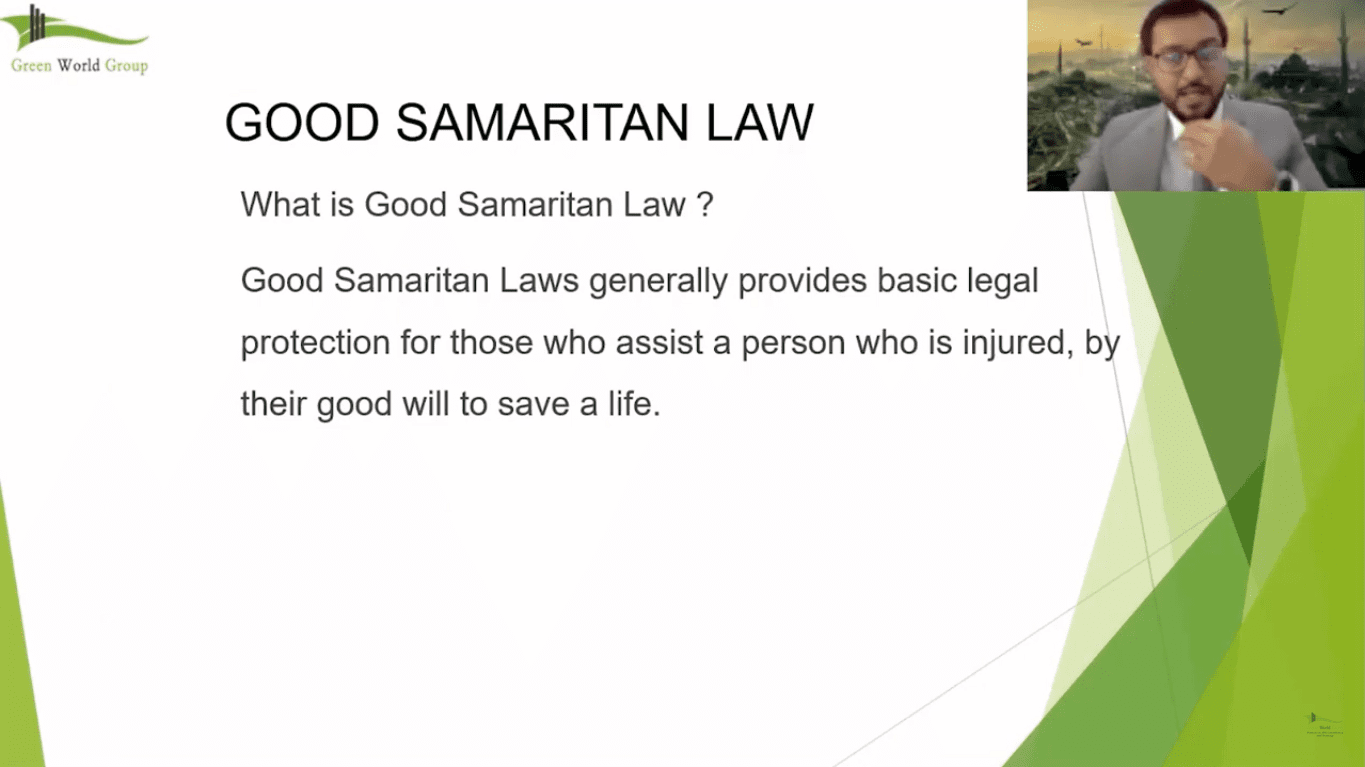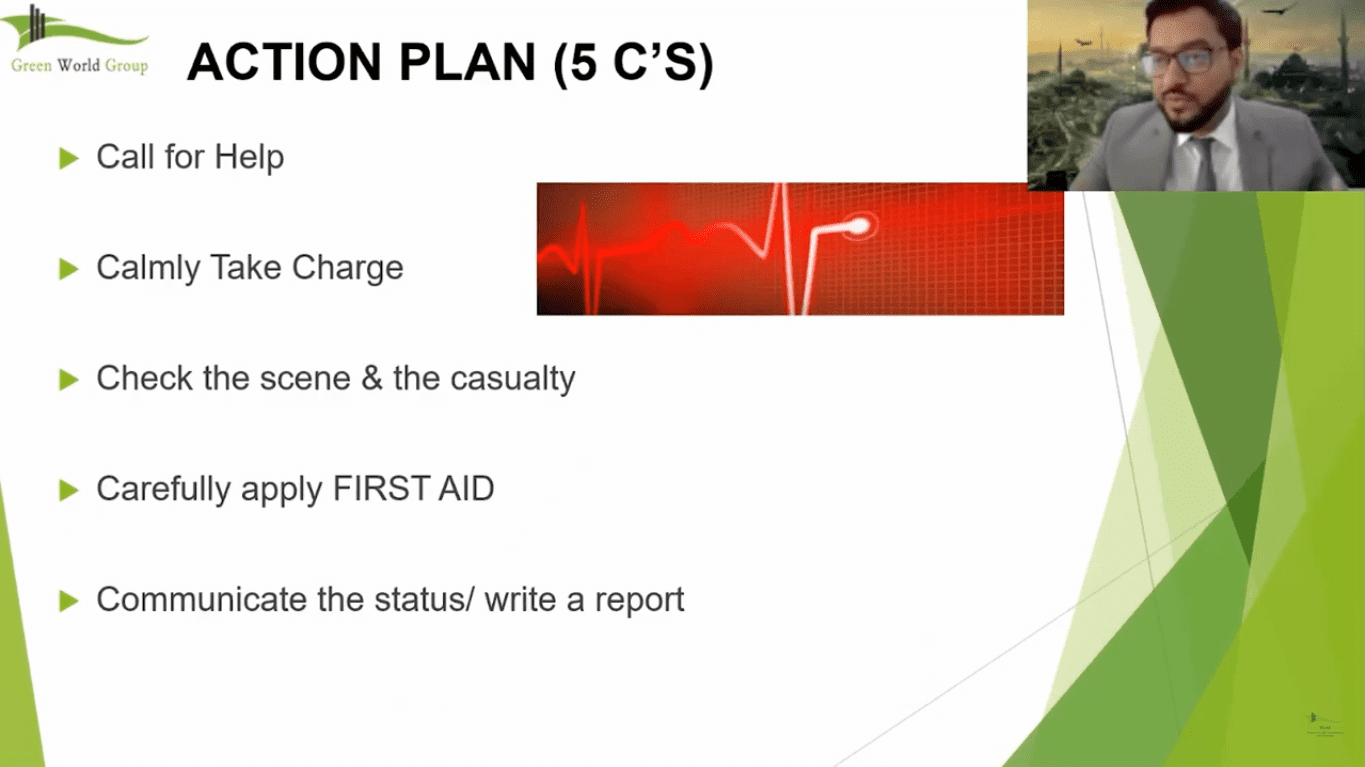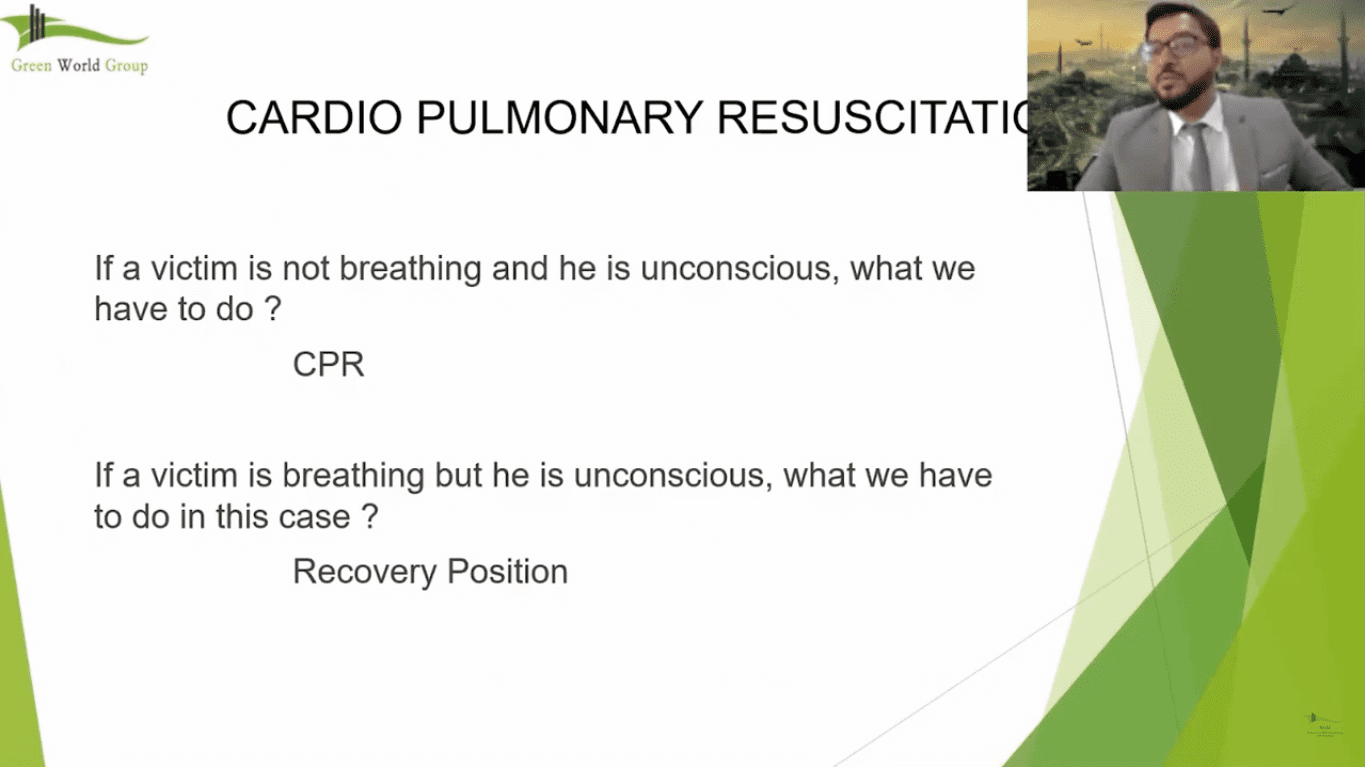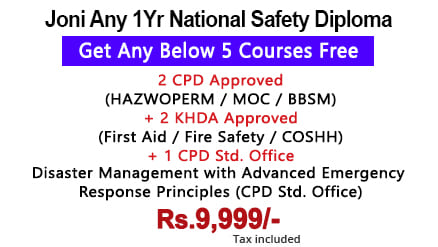
Basic First Aid Course, CPR & AED Training
This Article is about the basics of First Aid and CPR/AED Safety Training delivered by Mr. Fasik Ahmed, HSE Trainer from Green World Group, KSA. The below video gives detailed explanation on Basic First Aid training.
Video Transcription
Now, about CPR & First Aid even after me providing this course to you and you do not become a medical professional. I providing this course does not make me a medical professional. I don’t become a doctor.
But what is the point of this course then?
First aid is a basic necessity to every human being and everyone should have the knowledge to provide basic first aid for what purpose to preserve or to keep a person alive just for two things to occur either you get to the hospital or the ambulance comes to you.
We need to take these steps as quickly as possible and as competently as possible to keep that person alive and not create as many problems or not create secondary problems.
What is First Aid?
“It’s the first help that you would provide to aid someone in case of sickness, injury or close to fatality.”


Importance of first aid

First purpose is to preserve life
To keep that life/ that person alive as long enough again two things to happen either you get that person to the hospital or, when it comes to you.
Second purpose of the First Aid is to prevent secondary complications
One of the simplest way I can explain this to you is that the first thing you see when you open the first aid kit, you should be the medical gloves. The medical gloves save both of us, the victim as well as you apply on a first aid.
We never have the time to stop what we’re doing and we never have the time in case of an emergency to tell the individual, okay, hold on a second have to go wash my hands and come back quickly. It’s not possible.
We shouldn’t waste our time doing that. So the first thing we do is put on the gloves because our hands might not be a lot of bacteria or germs that can infect the individual’s wound. But not only that, we must protect ourselves from a blood borne pathogens that can be transmitted from the bleeding victim.
Again, we stay at the problem at hand and we don’t create more complications along the way.
Then comes the third purpose of the first aid kit is to promote speedy recovery
As soon as our human body gets hurt, we take care of it, we apply bandage, we sanitize it, start the healing process because our human body will regenerate as quickly as we apply first aid properly.
Here are the three major purposes
- Preserve life
- Prevent secondary complications
- Promote speed
Usually people would hesitate helping others because of legal reasons, people would say I couldn’t save this person while helping him, he passes a way then I will be legally obliged to be sued.
But there is a “Good Samaritan law” that is universally practiced, which is generally that if you’re doing it for good intention, if you were trying to help an individual or you’re trying to assist in saving that person’s life.
What is Good Samaritan law?

According to the Good Samaritan law, you will be pardoned. And despite you, despite you save that individual or that person is not able to be saved. But our mental consciousness would always be that what if we tried? So for those reasons, we must always try helping people as much as we can for Good Samaritan reasons.
Do's & Don'ts of universal precautions for first aider?

I want to talk about just the don’ts
During the pandemic, everyone is wearing masks but the universal don’ts
We must never prescribe any medicine because we’re not doctors, unless you are a doctor and you can prescribe someone medicine.
First aid kit is general it’s for everyone. There should be no edible medicine in there except for one which is aspirin and why aspirin is there?
“Please make sure you take our full classes, provided by Green World Group”
And the second thing that you should never declared that person gives up before you.
So we don’t have the right to declare death. Even when they get to the hospital, they will do as many things as possible to keep this person from dying. But after trying everything and if they do fail, then they will declare their perceptive.
But we don’t have the right to say that our job is try as much as we can, because sometimes it will take 20 or 30 cycles of CPR to revive someone. Sometimes it’ll take maybe a one, two or maybe five, but we should not give up. We should keep trying.
First aid 5 C's action plan

So what should be our action plan? – Action Plan 5 C’s
First thing is called for help i.e. Call for backup
Understand the situation, what it is so that it’s easy for you to communicate that the emergency units on the call. But you must call for backup because you could be there all day and nobody will come. Nobody would know. Right. The only thing you can do is call for help. So you must call for backwards.
Then Calmly take charge, if you are not calm, then you Spread panic, right? Again, panic is something that we’re trying to eliminate as much as possible. So calmly take charge.
Then Check the scene and casualties
There could be many other casualties could be still a hazardous situation developing, it could be a hazardous atmosphere, it could be more things that are happening. But you must check the scene.
Is it even safe for you to go in? maybe spread people out, get people away from the scene of the incident and look for casualties.
Then Carefully apply First Aid, reason why I am saying to carefully apply first aid is because First Aid kit is a box right?…
Now all the essentials are in there… if we act very harshly or we start running… what we do might accidentally release the content all over the place right?…
Now it’s in the box so it stays clean, safe and sanitized but once we harshly open all the contents may spread across the floor or wherever, it could be easily contaminated. So it’s no good to anybody.
And then the last final thing is Communicate the status / write a report
This is two parts. First communicate the status to whom if you have done the very first thing, which is call for help, well, by the time you get to this fifth action, it would be the ambulance might be arriving at this point.
If you’re doing it adequately, they will start setting up their AED and asking that process, what happened, how it happened so that they can then decide how to proceed. Right?
Then comes to the writer report now have, when everything is said and done, and they’ve loaded the person into the ambulance and they’re taking him to the hospital. So these are your five action plans.
What are the skills a First Aider should have?

It’s very important to get consent, to talk to an individual, who is a victim was just fall onto the floor. Figure out what the signs, what the symptoms are, and look for signs and symptoms in that speech pattern.
But most importantly, get the consent and give that comfort to that individual of who you are, what you can do and how you are going to help them.
Then it comes to the touch, you must touch the individual to see if there’s a heartbeat. Feel the heartbeat if you can, feel the breath on the outside of your fingers by putting it underneath his nostrils.
But listen and you can also apply your directly to this person’s chest to see if this person has a heartbeat or even the faintest.So once you’ve assessed the situation, you can now determine either you need to provide this person with CPR or first aid measures.
You must provide this person with that sense of comfort that
- Who you are
- What you can do
- You have notified the ambulance
- They are on their way
- Just hang in there
These are great words. These are very comforting words, helping this individual out through this time.
When you were talking about CPR, there are some major things we need to follow:

The simple hand formation of applying our fingers in this format, the reason why this is so helpful is because if you notice your pump, there’s a very deep point and then there’s a higher.
“So in order to even the surface out, we use the other hand, the other fingers that apply in this format to create a flatter surface it’s flat enough, to apply the proper amount of compression and apply the proper amount of pressure required to jumpstart.”
Then comes the airway, which needs to be provide that mouth to mouth breath. Now in our throats, there are two major ways. One, we eat food, it goes into that type of valve that goes into our stomach and then we’re constantly breathing.
So there’s another route that goes into our lungs. We are jump-starting the heart by compressions, fortunately applying that, but we’re also applying for oxygen, forcefully into the lungs, which is very important.
How to open the AIRWAY

Explaining the more details of how the hand formation should be in terms of opening the airways. So as you can see those two valves right there from the mouth and one for nostrils.
How to Administer Rescue Breathing

So there are different ways to check breathing
We can either put our ears, we can feel the breath sometimes onto our faces we can feel it on our hands, we can place a hand onto the chest. One of the best ways to feel the heartbeat is by putting the right to the source, which is the heart and the chest.
What is CPR? (Cardio Pulmonary Resuscitation)

“It is one of the quickest ways that any individual can provide to a person whose heart stopped to keep that person from passing away.”
How to do CPR?

We should provide CPR when we have identified that the individual, the victim does not have any vitals. But we should never provide CPR to an individual, if the persons are beating, then CPR is not your way to go, will create more problems. Obviously, we can stop a heart by applying constant pressure to the heart itself, it will skip a couple of beats.
When to Stop CPR? & How did we know?

Well, we should stop applying CPR when help arrives, not when you start hearing the sirens, but when the paramedics come and they set up their AEDs and their support and they start asking you questions, and they’ll take over from you.

Then third when life appears, of course, you don’t need CPR anymore. If you’ve jumpstarted the heart, you resuscitated a person back to life.

And then lastly is, when it’s pronounced there, obviously we don’t have the right to pronounce anyone dead. But if the paramedics have pronounced someone dead or the doctor’s pronounced someone dead, then we must respect that call because they didn’t just say, they’ve tried everything.
So, if a person is not breathing and he is unconscious, then yes, we will be providing someone with CPR.
How to use the AED (Automated External Defibrillator)

This is one of the best piece of tech that we have ever mankind has ever created to save people’s lives.
So, I will speak to you throughout the whole process that I’m telling you what you should do and how you shouldn’t be doing it.
This piece of tech is so smart that it will identify that if we are touching or if we are in contact with the individual, they’re the victim and it will pick up our heartbeat and say that there is life.
CPR consists of 30 compressions and two breaths i.e. one cycle of CPR. Once there is a heartbeat, even the faintest of heartbeats, this machine will tell you to stop and it will tell you that there is life and then you can place that person for recovery position.
What Should be in a First Aid Kit?

Well, you have a whole lot of things, three major tools that you have is scissors tweezers and alcohol swabs in there and we have different types of bandages for different purposes.
The only edible medicine that we can keep in the first aid kit is the aspirin. So individuals who would be going through a heart attack, we should be providing that person aspirin, but it’s not just take an aspirin with water, it has to be taken without water and the victim fought to it and then swallow it.
What an aspirin does is that it’s a blood thinner. And a heart attack occurs due to block it, due to cholesterol being forming, and a major artery, which won’t disperse.
But what happens is that once you take the aspirin, it thins the blood so that the blood will find its own list of gaps and keep the circulation going again.
This is a very temporary solution, to just keep this person alive till either do things happen, you get to the hospital, or the ambulance comes to you.
So when will you take this course with us, it will be much more detailed, of course we will be talking about major things in more detail about heart attack patients, strokes, heat strokes, exhaustion, not only that, we’ll talk about cuts, internal bleeding, spinal cord injuries and contagious diseases.
So these are very essential things that I believe each and every individual must have knowledge of and so that they can take care of themselves as well as the loved ones around them.

 NEBOSH CERTIFICATE
NEBOSH CERTIFICATE NEBOSH DIPLOMA
NEBOSH DIPLOMA IOSH
IOSH SAFETY DIPLOMA
SAFETY DIPLOMA CPD UK
CPD UK ROSPA UK
ROSPA UK FOOD SAFETY
FOOD SAFETY 




